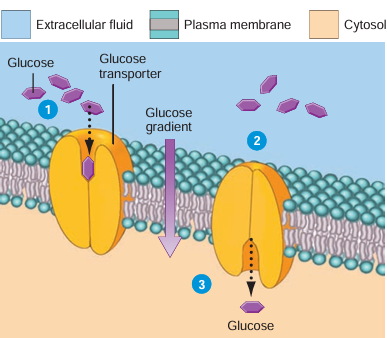Carrier Mediated Facilitated diffusion explained: Lecture and notes of Transport across the cell membrane
In carrier mediated facilitated diffusion, a carrier (also called a trans porter) is used to move a solute down its concentration gradient across the plasma membrane. The solute binds to a specific carrier on one side of the membrane and is released on the other side after the carrier undergoes a change in shape.
The solute binds more often to the carrier on the side of the membrane with a higher concentration of solute. Once the concentration is the same on both sides of the membrane, solute molecules bind to the carrier on the cytosolic side and move out to the extracellular fluid as rapidly as they bind to the carrier on the extracellular side and move into the cytosol.
The rate of carrier-mediated facilitated diffusion (how quickly it occurs) is determined by the steepness of the concentration gradient across the membrane. The number of carriers available in a plasma membrane places an upper limit, called the transport maximum, on the rate at which facilitated diffusion can occur.
Once all of the carriers are occupied, the transport maximum is reached, and a further increase in the concentration gradient does not increase the rate of facilitated diffusion. Thus, much like a completely saturated sponge can absorb no more water, the process of carrier-mediated
facilitated diffusion exhibits saturation.
For other topics lectures you can check below links
Cell overview : Click Here
Plasma Membrane Structure and Function: Click Here
Membrane Protein : Click Here
Cell Membrane Permeability: Click Here
Channel Mediated Facilitated diffusion | Cellular Transport : Click Here
